| | Ivanov Annotates |
| | GM Alexander Ivanov |
| | November 2011 |
| | 
GM Alexander Ivanov 2636
GM Mikheil Kekelidze 2592
Bradley Open 2011 (4)
[B42]
Sicilian Defense
1.e4 c5 2.Nf3 e6 3.d4 cxd4 4.Nxd4 a6 5.Bd3 Qb6 Lines with Qb6 (also after 2...Nc6 3.d4 cxd4 4.Nxd4) have become popular lately. 6.Nb3 The alternative is [6.c3] 6...Qc7 7.0-0 Nf6 8.f4 In the hedgehog formation possible after 8.c4 d6 it’s hard to say whether White gained or lost a tempo placing the Knight on b3 early in the opening. 8...d6 9.a4 b6 10.Be3 Nbd7 Of course both 11.c4 and 11.Nc3 are playable. Houdini ‘likes’ 11.Nd2 at fi rst, then makes 11.Nc3 its fi rst line, assessing the position as equal in both cases. 11.N1d2 Bb7 12.Qe2 h5?! This is too ambitious. Completing the development after 11...Be7 followed by 0-0 would be better. 13.a5 [13.f5 e5 14.a5 b5 15.c4 b4 16.Ra4 Ng4 17.Rxb4 Nxe3 18.Qxe3 Be7 with compensation] 13...b5 14.c4 This is the point of 11.Nd2 14... b4 There is nothing better. [14... bxc4?! 15.Nxc4+/- Nxe4 16.Nb6 and the best thing for Black is to sac the exchange: 16...Qd8 17.Nxa8 Qxa8 18.Nd2!?+/-] 15.Ra4 Nc5 [15...Ng4!? 16.Rxb4 Nxe3 17.Qxe3 d5 (17...Be7!? with compensation) 18.Rxb7 (18.c5!?) 18...Qxb7 19.exd5 Qa7 (forced) +/=] 16.Rxb4 Nxd3 17.Qxd3 d5?! [Better was 17...Be7+/= with some play for the pawn.] 18.Rxb7 Qxb7 19.exd5 Bb4 [19...exd5 20.Re1 0-0-0 21.Bb6+-] 20.Nc5?! This and the next White’s move are trying to prevent Black from castling short. The computer prefers the ‘materialistic’ [20.dxe6 0-0 21.exf7+ Rxf7 22.Nf3+/-] 20... Qc7 21.Nce4 [21.Ndb3 0-0 22.dxe6 Rad8 23.Qe2+/=] 21...Ng4? After this mistake Black is losing again. Better was [21...Nxe4 22.Nxe4 exd5 (forced) (22...0-0? 23.Ng5 g6 24.dxe6+-) 23.Ng5 (23.cxd5 Qxa5 24.Ng5 Rd8 transposes) 23...Rd8 24.cxd5 Qxa5 25.Rd1 Be7= 26.Qe4 Rh6!?] 22.Bb6 Qd7 23.h3 Nh6 24.Nf3 f6 25.Qb3 [25.Bc5 Bxc5+ 26.Nxc5 Qa7 27.b4+-] 25...exd5 Black had 19m left 26.cxd5 Bd6 27.Nxd6+ [Houdini suggests the immediate 27.Ne5!? fxe5 28.Nxd6+ Qxd6 29.fxe5+- with a crushing attack for the rook. My choice is much more ‘human’.] 27...Qxd6 28.Qa4+ Kf7 [28...Kf8 is insuffi cient due to 29.Qc4 Kg8 30.Re1+-] 29.Ne5+!
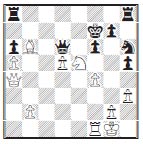
This was the reason for choosing 25.Qb3 29...Kg8 30.Ng6 Kh7 [In the ending after 30...Rh7 31.Qe4 f5 32.Qe6+ Qxe6 33.dxe6 all three Black pieces on the kingside cannot move.] 31.Nxh8 Qxd5 32.Rd1 Qf5 33.Qd7 The simplest way to realize the advantage. 33...Rxh8 34.Qxf5+ Nxf5 35.b4 h4 36.b5 Ra8 37.bxa6?! Time trouble. [37.Rd8+- was winning right away.] 37...Rxa6 38.Rd7 Ra8 39.Rd8 Ra6 40.Kf2 Ne7 41.Kf3 Kg6 42.Kg4 Kf7 43.Rd7 Ke6 44.Ra7 Rxa7 45.Bxa7 Nd5 46.f5+ Ke5 47.a6 Ke4 48.Bf2 1-0
GM Alexander Ivanov 2627
IM David Vigorito 2535
Seacoast Open 2011 (4)
[B89] Sicilian Defense
1.e4 c5 2.Nf3 d6 3.d4 cxd4 4.Nxd4 Nf6 5.Nc3 a6 6.Bc4 e6 7.Bb3 Nc6 8.Be3 Be7 In our previous game my opponent had chosen 8...Qc7 9.f4 Na5 10.g4 with sharp play (Ivanov-Vigorito, Mass. Open 2011). 9.Qe2 The most popular move. 9...Qc7 [9...0-0; 9...Na5] 10.0-0-0 Na5 The alternatives are 10...0-0 and 10... b5 11.g4 b5 12.g5 Nxb3+ 13.axb3 Nd7 14.h4 [The sacrifi ce 14.Nf5 which occured in many games leads to equal play after 14...exf5 15.Nd5 Qd8 16.exf5 Bb7 17.f6 gxf6 18.Rhe1 Bxd5 19.Rxd5 Rg8 and so on.] 14...b4 15.Na2 I was sure my quick-playing opponent was prepared for the more obvious 15.Na4 [15.Na4 Nc5 16.h5 Nxe4 unclear (16...Bd7!?) ] 15...Rb8 [According to theory Black shouldn’t be afraid of Nb5 after 15...a5! and if 16.Nb5?! then 16...Qc6 17.Qc4 Nc5 18.Rxd6 Bxd6 19.Nxd6+ Qxd6 20.Bxc5 Qc7=/+] 16.h5 Nc5 17.g6 Bf6 18.gxf7+ Kxf7 19.Kb1 [The active 19.Qc4 doesn’t bring any dividends: 19...a5 20.Nf5?! Rd8 21.Nxd6+ Rxd6 didn’t like 22.Rxd6 Nxb3+! 23.Qxb3 Qxd6-/+] 19...a5 20.Rhg1 Rf8 21.Bg5 Bxd4 This move surprised me. I was expecting [21...Kg8!? with double-edged play, for example 22.h6 g6 23.Bxf6 Rxf6 24.Nb5 Ba6! 25.Nxc7 Bxe2 26.Rxd6 Rxf2 27.Nc1 unclear (27. Nxe6?! Rf6!=/+) ] 22.Rxd4 e5 23.Rdd1 Be6?! This allows White to start a dangerous attack [23...Kg8 unclear 24.Nc1 unclear (24.Bh6?! Rf7 25.Rg3 Kh8 26.Rdg1 Ne6=/+) ] 24.f4! h6?! [24...Ke8!? 25.Nc1 (25. f5 Bf7 unclear 26.Bd2 a4 27.bxa4 b3 28.cxb3 Bxb3; 25.fxe5 dxe5 26.Nc1 unclear) 25...a4 26.fxe5 dxe5 27.bxa4 b3 unclear 28.Nxb3!? Nxb3 29.cxb3 Bxb3 30.Rd3 Qb6 unclear] 25.f5?! Looks natural, but not to Houdini! [25.fxe5! dxe5 (25...hxg5 26.exd6 Qc6 27.Rxg5+/-) 26.Be3 a4 27.Rg6! axb3 28.cxb3 Bxb3 29.Nc1! Kg8 (29...Bxd1 30.Qc4+ Ke8 31.Bxc5+-) 30.Rdg1 Rf7 31.Bxh6+-] Of course it’s superhuman to see all these sharp lines. 25... Bc8? [Better was 25...hxg5 26.Rxg5 (that was my intention) 26...Ke8 27.fxe6 Nxe6 28.Rg3 Rf6 unclear] 26.Bh4?! [After 26.Be3 I didn’t like 26...Nxe4 27.Qg4 Kg8 28.Qxe4 Bxf5 29.Qg2 a4 with counterplay for the missing piece, but failed to see 27.Bxh6!+/-] 26...Ke8 [Black stubbornly refuses to move his King to g8, which was better than the text even here, although now it’s less safe than on move 23: 26... Kg8 27.f6 Rf7 28.Rg6 Ne6 29.Qe3 Nf4 30.Rdg1!+/-] 27.Rg6 Now White should win. 27...Nxe4 [27... Rb6 28.Nc1+-] 28.Qxe4?! [28. Rdxd6 Bxf5 29.Rde6+!+-] 28...Bxf5 29.Qg2 Rc8 30.Rd2?! A human decision. The computer has no fears: [30.Nc3!? bxc3 31.Rgxd6+- cxb2 32.Rd8+ Rxd8 (32...Kf7 33.Qd5++- ) 33.Rxd8+ Qxd8 34.Bxd8 Kxd8 35.Qxg7; 30.Qd5!? Bxc2+ (30... Rf7 31.Nc3+-) 31.Ka1+-] 30... Bxg6 31.Qxg6+ Rf7 32.Nc1+/- I calculated up to here before playing 27.Rg6 and concluded that with queens on the board and misplaced Black king White’s attack should be decisive. Still everything hangs on a tactical nuance. 32...Kf8 Heading in the right direction at last, but now it’s too late. 33.Qh7 [Of course not 33.Rxd6? Kg8 with unclear play] 33...Rf4 [33...Rf1 loses to the same trick: 34.Rg2 Qf7 35.Be7+! Kxe7 36.Rxg7+-] 34.Rg2 Qf7 35.Be7+!
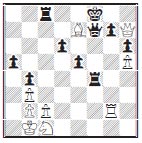
35...Ke8 [35...Kxe7 36.Rxg7+- Rf8 37.Qxh6] 36.Rxg7 Kxe7 37.Qxh6 Rg8 38.Rxf7+ Rxf7 39.Qe3 Rf1 The time control was game/65 and I remember spending most of the remaining time calculating the following forced sequence: 40.h6 Rgg1 [40...Rh1 41.h7 Rxh7 42.Qa7++-] 41.h7 Rh1 42.Qg5+ Kf7 43.Qg8+! [43.Ka2 Rxh7! unclear] 43...Ke7 44.Ka2 Rxc1 45.Qg5+ Ke6 46.Qxc1 Rxc1 47.h8Q Rxc2 48.Qe8+?! [Time trouble. 48.Qh3++- wins a rook.] 48... Kd5 49.Qa8+ Black resigned because he loses his a and b pawns, just failing to create a fortress by Rc5. 1-0
GM Alexander Ivanov 2589
GM Tamaz Gelashvili 2720
Eastern Class Championships
2012 (4)
[B00] Nimzovich Defense
1.e4 Nc6 The Nimzovich Defense is seldom played on a GM level, partly because it can lead to transpositions after, say, 2.Nf3 e5. 2.d4 e5 3.d5 3.Nf3 transposes to Scotch. 3...Nce7 4.Nf3 Ng6 5.h4 h5 6.Bg5 Be7?! This was my second game against a GM in this opening. The fi rst one continued [6...Nf6 7.Nc3 Bc5 8.Na4 Bb4+ 9.c3 Be7 10.Bxf6 Bxf6 11.d6 cxd6 12.g3 with compensation, Ivanov-Benjamin USA ch 1996 ] Black’s 6th move allows White to double Black’s pawns right away. 7.d6+/= cxd6 8.Nc3 Nf6 9.Bxf6 Bxf6 10.g3 Qa5?! Black’s choice of the opening looked risky, but only this premature activity makes his position bad. [10...a6+/=; 10... Be7+/=; 10...Qb6?! 11.Nd5 Qxb2 12.Rb1 Qa3 (12...Qxa2 13.Ra1 Qb2 14.Bc4+-) 13.Nc7+ Kd8 14.Nxa8+- ] 11.Nd2+/- This is better than [11. Bc4 Qc5 (11...d5!? 12.Qxd5 Qxd5 13.Bxd5+/=) 12.Qd3 a6+/=] 11...d5 planning to trade the passive Ng6 for one of White knights before the other one helps it, but now it’s too late. The computer recommendation [11...Qc5 12.Nb3 Qc6 13.Bb5 Qc7 14.Nd5 Qb8+/=] doesn’t look appealing either. 12.Nxd5 Ne7 13.b4!
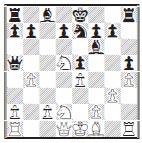
[Much less clear is 13.Nxf6+?! gxf6 14.Qf3 f5 15.Bc4 b5!? unclear] 13...Qd8 14.Nc4 Nxd5? The only chance not to get crushed was to give up the second d-pawn right away: [14...d6 15.Nxf6+ gxf6 16.Qxd6!? (16.Nxd6+ Kf8+/-) 16...Be6 17.0-0-0+/-] 15.Nd6++- This zwischenzug cuts Black’s position in two. Now White is winning. [15. Qxd5? 0-0+/=] 15...Ke7 16.Qxd5 Qb6 [16...Qc7 17.0-0-0 Qc3 18.Bc4 Qa1+ 19.Kd2 Qd4+ (19...Qb2 20.Ke3+-) 20.Qxd4 exd4 I remember calculating up to this point. Now the most convincing win for White is 21.e5 Bxe5 22.Nxf7 d5 23.Nxh8 dxc4 24.Ng6+ Kf6 25.Nxe5 Kxe5 26.Rhe1+ Kd5 27.Re8+-] 17.0-0-0 Qxb4 [17...Rf8 18.Bh3 Kd8 19.Bxd7!+-] 18.Bc4 Qa4 There is no other way to defend against Nxc8+ followed by captures on d7 and f7 (18...Kd8 19.Nf7++-) The inclusion of [18...Qa3+ doesn’t change much: 19.Kb1 Qa4 20.f4!?+- ] 19.Rd3 There were other ways as well: [19.f4+-] 19...a6 [If 19...Qc6 then 20.Qxf7+ Kd8 21.Bb5 Qb6 22.Rhd1 Kc7 23.Rc3+ Kb8 24.Nxc8 (24.Bxd7+-) 24...Qxb5 25.Rxd7+-] 20.Qc5 b6 21.Nxc8+ 1-0
GM Alexander Ivanov 2565
Ted Belanoff 2127
Portsmouth Open 2012 (4)
[C70] Ruy Lopez
1.e4 e5 2.Nf3 Nc6 3.Bb5 a6 4.Ba4 b5 5.Bb3 Nf6 Since Ruy Lopez had his book published in 1561 there have been quite a number of chess players trying to fi nd the best move order in his opening. Usually Black plays Nf6 on move 4 postponing b7-b5 until later. Can White exploit the difference? 6.d4 [The direct attack 6.Ng5?! like in the Two Knights Defense is not so good because of 6...d5 and if 7.exd5 Nd4 and the Bb3 will be exchanged for the knight.; 6.0-0 transposes to the Archangelsk Variation after 6...Bb7 (or to the Neo-Archangelsk after 6...Bc5) ] Houdini also prefers 6.d4 6...exd4?! [Although 6...d6 looks scary here because of 7.Ng5 , holding the center looks like the best option, for example, 7...d5 8.dxe5 Nxe5 9.Nc3!? d4!? 10.Nd5 c5 11.Nxf6+ gxf6 12.Bd5 Ra7 13.Nf3 Bg4 unclear] 7.e5 Ne4 [If 7...Ng4 then 8.0-0+/= (8.Bxf7+? Kxf7 9.Ng5+ Kg8 10.Qxg4=/+) ] 8.Bd5 [A safer way to get a plus was 8.0-0!?+/= Nc5 (8...d5 9.exd6 Nxd6 10.Nxd4+/-) 9.Nxd4 Nxd4 10.Qxd4 Bb7 11.Nc3 and if 11...Nxb3 12.axb3 d5 , then 13.exd6 (13.b4 Qe7! 14.Nxd5 Rd8 15.Nxe7 Rxd4 16.c3 Re4 17.Nf5 Rxe5=) 13...Qxd6 14.Re1+ Be7 15.Qxg7 (15.Qh4+/=) 15...0-0-0 16.Qxf7 Bf6 17.f3+/=] 8...Bb4+ [8...Nc5 9.Nxd4 Bb7 10.0-0 Ne6 (10... Nxd4 11.Bxb7 Nxb7 12.Qxd4+/=) 11.c3!?+/=] 9.Kf1 Sharper and better than [9.Nbd2 Nxd2 10.Bxd2 Bxd2+ 11.Qxd2 Rb8=] 9...f5 10.a3 [On 10.Nxd4!? Qh4 looked dangerous. According to a computer 11.Be3 Nxd4 (11...f4? 12.Nf3! Qg4 13.Bc1+/- Houdini) 12.Bxa8 Ne6+/=] 10...Bc5 [10...Ba5!? 11.Nxd4 Nxd4 12.Bxa8 Ne6+/=] 11.Nbd2 Bb7 12.Qe1 [Here I spent quite a while considering 12.Nxe4!? fxe4 13.Bxe4 0-0 (13...Qe7 14.Bg5 Qe6 15.Qd3 0-0!? unclear) 14.Qd3 Rxf3!? (14...Nxe5? 15.Bxh7+! Kh8 16.Nxe5) 15.Qxf3 Nxe5 which looked unclear; 16.Qf5+/= Houdini] 12...Ng5? This allows a nice winning sequence. After the correct [12...Nxd2+ 13.Bxd2 h6 or 13...Na5!? things would be far from clear ] 13.Nxg5 Qxg5 14.Ne4 Qe7 15.Bg5 Qf8 [15...Qxe5 16.Nxc5+-] 16.Nd6+! (D) 1-0
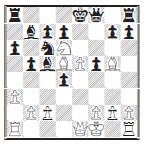
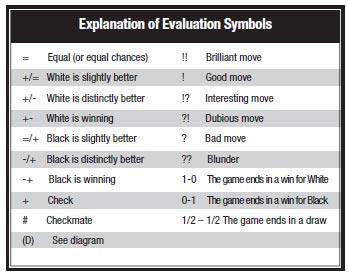
|